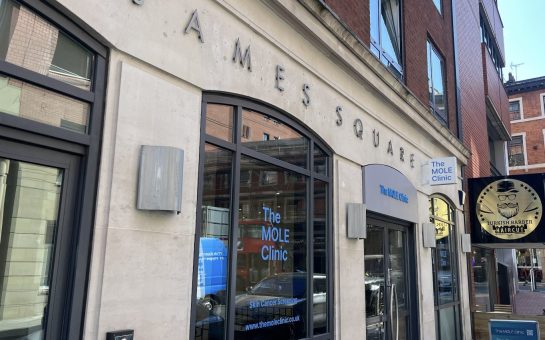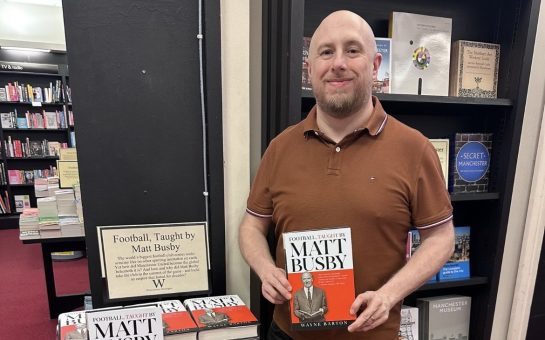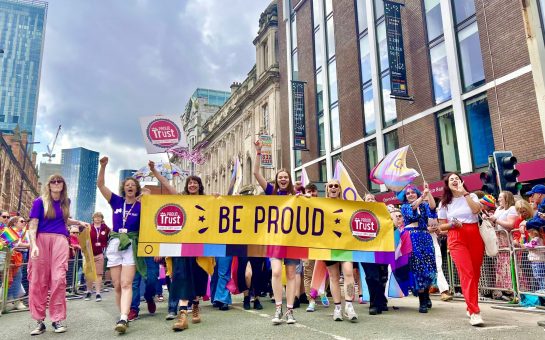Through a cluster of trees and a short meander down a gravel path is the house where SS Commandant Rudolf Höss, his wife Hedwig Hensel, and their five children lived.
It’s a pretty, picturesque place, where Höss’ two boys and three girls would happily play in a quiet garden where now the only sounds to break the heavy silence are the chirping of birds in the sentient trees.
Not 100ft from where the children played lies the camp where more than a million people were massacred in less than five years.
You know the name well. The camp was Auschwitz.
The infamous concentration camp sign which reads ‘arbeit macht frei’ (‘work sets you free’) is only a stone’s throw away, while symmetrical buildings flanked by systematic and compulsively arranged paths have a haunting purposefulness to them.
This is a place that was built to not only house misery, but to manufacture it on a scale never seen before.
It’s a powerful experience for any adult to witness. But some 200 young students from across the North West made the journey to Auschwitz last week as part of the Holocaust Educational Trust’s (HET) 25th anniversary.

HAUNTING: A watchtower looks out as barbed wire fences mark the perimeter (picture courtesy of grahamsimage.com)
The first stop was the Jewish cemetery at Oświęcim – the first impression you make is the fact that it’s in a fairly overgrown state.
In this town, where the Auschwitz extermination camp was based and where a large Jewish community lived prior to the beginning of the Second World War, there are now no Jewish inhabitants.
It’s shocking that this bustling town occupies the site of one of the worst atrocities in human history.
Before the visit, Lucy Matthews, 17, from Loreto College, said it was important to remember what happened there.
She said: “My grandparents said they would never come to Auschwitz because it happened in their lifetime. But it’s different for us and it’s important that we go and remember.
“If only two people from each college can go we really need to pass on what we learn.”
Lucy’s classmate Liam Morris, also 17, said: “I think you can read about it and talk about it, but then to go and to see the people that were there and feel the atmosphere; that’s completely different.”
HALT! The stark sign makes no attempt to hide the price of attempting to escape
Stephen O’Brien, MP for Eddisbury, South Cheshire, was equally sure of the importance of remembering through seeing.
He told MM: “To be able to visit alongside those who are the age of my own children and to go through this experience together demonstrates how we need to keep alive the sense of outrage at what took place, and the sense of shared responsibility we all have for the values of freedom, non-discrimination, and the rule of law.”
Walking through the first camp, in rooms full of the last vestiges of human occupation in the camp, people wander in complete silence. Only the guides are willing to talk.
In the buildings that seem to run on endlessly, thousands of shaving brushes, glasses, prayer mats, shoes, and children’s clothes and dolls lie behind glass walls in an appallingly graphic manifestation of the Holocaust.
How can the mind think of those bodies that once grew the mountain of human hair, shaved from the heads of men, women and children going to their deaths?
From the thousands upon thousands, how can a single plait sat atop the pile catch the eye? Was it lovingly entwined by a mother’s fingers before a daughter ran to play? Or was it painfully woven in fear to pass the time, to calm a crying child?
It joins the others, forever condemned to sit behind glass, to be watched by glistening eyes, moist with unspoken, unknown feelings.

SOMBRE: Often the only person speaking at Auschwitz is the guide (picture courtesy of grahamsimage.com)
Further on visitors reach barracks 10 and 11. Between these buildings there is a long strip of land used solely for the eradication of human life.
A rubber wall sits in the centre, built to stop bullets bouncing off the brick and injuring the guards. An unnerving and distressing act of self-preservation in the face of the unspeakable pain they inflicted.
The windows of the adjoining buildings are boarded over so fellow prisoners could not hear the resistance of other inmates.
Flowers and candles lie at the foot of the wall where mournful visitors pay homage and respect.
Acts of remembrance like this are carried out by every student taking part in the HET’s Lessons from Auschwitz Project.
Since 1999, more than 21,000 students and teachers have paid their own, individual recognition.
Chief Executive of the HET, Karen Pollock MBE, said: “The visit enables young people to see for themselves where racism, prejudice, and anti-Semitism can ultimately lead and its importance is demonstrated by the inspiring work students go on to do in their local communities.”
In the absorbing environment of Auschwitz it’s clear that these lessons must be learned so that the horrors of Nazism can never happen again.
One of the building’s jails still houses several cells for those receiving further punishment – the ‘standing cells’.
What kind of hell went on in here is barely imaginable, in a space that would make a telephone box appear roomy.
Yet four people would be forced to crawl through a hole and stand side by side for the entire night after working ceaselessly all day, bodies cramped together, unable to breathe, to stretch, to move… aching limbs shuddering under untold weight.
It’s difficult to comprehend suffering such as this; it is impossible to comprehend the mindset of those forcing humans into such suffering.
The entire camp is cordoned off by an electric fence, beyond which only 144 prisoners are known to have escaped. Often seen as the easiest way of committing suicide, the signs forbidding such attempts are still in place.
A skull and cross bones sits above the word ‘HALT!’ in a striking image of the death that would face almost every prisoner, through a variety of ghastly methods.

SQUALID: Students learn about the horrendous and appalling conditions of the camp’s latrines (picture courtesy of grahamsimage.com)
After the visit, Lucy and Liam had very different reactions.
Lucy said: “To see where so many people died was just horrible… horrible”
“The hair was very upsetting,” Liam said. “All the stuff the Nazis took off the prisoners wasn’t because they didn’t know what to do with it; it was because they were going to use it again.”
Such recycling was the product of valuing everyday possessions above the lives of their owners.
The second camp the group visited was haunting in its dramatic difference from Auschwitz I. Auschwitz-Birkenau, or Auschwitz II, was constructed because its predecessor was thought too small for the purposes of extermination. The gross extent of the camp is beyond comprehension.
Walking around the lanes of a place that could easily occupy a small village (and did, before Birkenau was constructed in place of Brzezinka), seeing the bunks, the mass latrines, and the remains of crematoria destroyed by dynamite, visitors attempt to understand the overwhelming volume of human devastation.
Here, in 1944, more than 90,000 prisoners were held for slave labour and mass extermination.
Walking down the train tracks a guilt hangs over the visitors. We will all walk back this way shortly. Most of those who used to walk this path would not.
Sanya Nadeem, 16, from Parrs Wood High School, was stunned by what she saw.
“It is shocking how vast the whole thing was,” she said.
“When you see it in person it hits you how horrible it was. I just don’t understand how someone could watch the light go out of someone’s eyes and not do anything.”
As was Orlagh Fallon, 17, from Withington Girls’ School. She said: “I was shocked at the sheer size of it. It is just so industrial, like a factory; it removes human feelings. Compared to the normalities of the town nearby, I find it really shocking.”
On the walls of one of the children’s barracks there is a display of artwork. According to guide Dorata Zak, the wall mural of a child with a book walking to school represents what children in the camp dreamed of.
The wall facing it, where four children walk in a line to an unknown location, carrying dolls and teddy-bears, is the camp’s children in reality: being led to the gas chamber.
A guide at Auschwitz for more than 20 years, Ms Zak told MM: “We expect various people’s reactions and we learn to deal with it. I have learned not to take it too personal and not to take it home. You can’t take it home.”
Nevertheless, she had a perspective of bleak honesty.
“Your great grandparents could have been wearing nets made of hair from camp victims,” she said.
“The majority of people that were killed at Auschwitz were women and children, usually younger than 14. Why? Because women could not work like men, and though the children may have managed, how could she leave them behind? Look at the woman on this picture. How could she leave seven children behind?
“This could have been your grandparents.”
Throughout the visit, students were encouraged to personally reflect on what their experience meant to them, no matter what background they had, as human beings. There was a huge range of responses.

REMEMBRANCE: Students light candles by the tracks where many of those who came to die would have disembarked (picture courtesy of grahamsimage.com)
Halima Sumar, 17, from Xaverian Sixth Form College, said: “What shocks me is the mentality of the Nazis,” she said. “I don’t think anyone in this society would do what they did.”
Later thinking on her experience, she said: “Giving £3 a month to a children’s appeal is not enough. People need to know more about what is happening in the world.”
Eddy Boyle, 17, from Manchester Grammar School, said: “I think it will take me a few days to process the emotions. It’s incredibly overwhelming.”
A teacher at Carnforth High School, Jo Gluth had not been to Auschwitz since graduating from university.
Visiting this time, she said: “The enormity of Birkenau, the epic size of it is breath-taking in a completely negative way. It makes me want to teach it for months and months, and make sure the students who aren’t lucky enough to come here can understand it better.”
The personal intensity of these reactions was on full display at the ceremony closing the visit. In the shadow of the ruins of Crematorium 2, next to the Birkenau Memorial, some 200 students, teachers, journalists, and guides were addressed by Rabbi Barry Markus.
“An assault on difference is really an assault on humanity,” he said.
“People ask me why we need to remember the Holocaust. I would love to be able to say that the Holocaust was an aberration, but wherever I look today I see things that make me realise I’m not allowed to. We must remember that we are not condemned to endlessly repeat the mistakes of the past.
“People also ask me, where was God in this act? How has this been possible? What we should ask instead is how has this been humanly possible, and where the hell was man?”
Five students read poems commemorating the lives of those lost, and the group observed a minute’s silence. If each victim of Auschwitz was to receive such a minute, it is estimated that the group of 200 would have to be silent for three years.
On the long walk back to the entrance of Birkenau, the visitors lit candles and set them down in what they felt was a place of personal meaning. Once again the emotional weight of the day was visible on many faces.
Karen Van Coevorden, lead educator with the Lessons from Auschwitz Project, told MM: “People expect to be sad and cry and be upset, but there is no right or wrong way to react.
“By participating, students are ensuring that those who perished are not forgotten.”
This is the message surely all visitors to Auschwitz take, irrespective of their personal feelings.
I must not forget, you think. I must never forget.
First picture at top courtesy of C Puisney, with thanks.
For more on this story and many others, follow Mancunian Matters on Twitter and Facebook.



